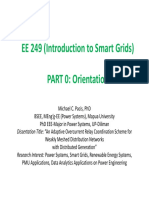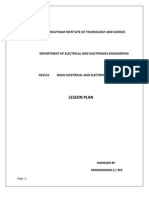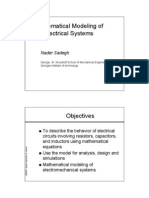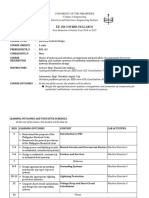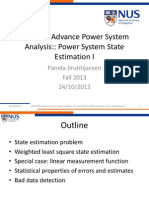Mathematical Models and Algorithms
Uploaded by
ijctcmjournalMathematical Models and Algorithms
Uploaded by
ijctcmjournalInternational Journal of Control Theory and Computer Modeling (IJCTCM) Vol.3, No.
6, November 2013
MATHEMATICAL MODELS AND ALGORITHMS CHALLENGES
Kenneth Mapoka1, Howard Masebu2 and Tranos Zuva3
1&2
Department of Agricultural Engineering and Land Planning, Botswana College of Agriculture, Gaborone, Botswana 3 Tshwane University of Technology, Pretoria, South Africa
ABSTRACT
This paper succinctly illustrates challenges encountered when modelling systems mathematically. Mathematical modelling entirely entails math symbols, numbers and relations forming a functional equation. These mathematical equations can represent any system of interests, also provides ease computer simulations. Mathematical models are extensively utilized in different fields i.e. engineering, by scientists, and analysts to give a clear understanding of the problem. Modelling contributed a lot since inversion of the concept. Simple and complex structures erected as a result of modelling. In that sense modelling is an important part of engineering. It can be referred to as the primary building block of every system. A complex model however is not an ideal solution. Engineers have to be cautious not to discard all information as this might render the designed model useless as detailed in this paper the model should be simple with all necessary and relevant data. Basically the purpose of this paper is to show the importance and clearly explain in detail challenges encountered when modelling
KEYWORDS
Modelling, Algorithm, Replica, Taxonomy,Challenges & Uncertainty
1. INTRODUCTION
Over the years Mathematical models were used and still in recent history have received a tremendous conceptualisation in engineering. Mathematical models can be defined as simply expressing a real world system in terms of math symbols, numbers and relations forming a functional mathematical equation. The equations representing a system come in different forms algebraic, fractional quadratics and linear or non-linear systems depending much on the phenomena being modelled. Real world system comprises of different, unrelated phenomena hence numerous representation or formulation of each phenomenon. Basically the derived equation for a particular phenomenon holds less but relevant information and system dynamics needed to be acknowledged henceforth dealt with. In engineering, simplicity, conciseness and understanding are significant milestones for every project in engineering. Engineers pride themselves on these milestones. Too much detailed information on a model imposes difficulties when developing algorithms and may henceforth bring challenges during system simulation: where simulation is the art of emulating a real-world process.
DOI : 10.5121/ijctcm.2013.3602
21
International Journal of Control Theory and Computer Modeling (IJCTCM) Vol.3, No.6, November 2013
2. MODELLING
Mathematical modelling in simply terms can be described as the building block of science, computing, analysing and engineering. In control engineering, modelling:mathematical
representation of a physical phenomenon, system or device, mathematical models takes many forms such as dynamic system models, statistical models, game models, differential equation...etc.simulation:a computer program, or package, that attempts to simulate or imitate an abstract model of a particular system or device. These two main concepts are complementary components coexist. Simulation forms an integral with abstract mathematical models. The sole purpose of simulation is to establish some benchmarking, new insights to a problem, predict behaviour for systems. The preliminary measure is to develop a model, write algorithm and finally simulate the abstract model for further interpretation. Simulation of the model has an added advantage since this procedure can be executed as many times until an effective and sufficient model is attained[1-3]. In control engineering simulations are executed using programs such as MATLAB, SCILAB, C, C++, Linux etc. These programs have their own merits of understanding and performance[4-6]. The elementary/rudimentary of modeling are very important therefore challenges need to be addressed to improve model efficacy and validation on simulations.Simulations reassure quality of a model hence validation.Quality of feasibility
in science, computing and engineering is thus of modelling. Take for instance, building bridges to skyscrapers and cars to computers, modelling has to be done to evaluate and understand the attributes that may impact the system orientation. Models are used as learning progressions, cheap to design and execute than real counterparts and fail-safe replicas or prototypes (dummies). Therefore, models and their unique utilization are expressions of inter subjective understandings [7].
2.1. Importancesof Mathematical Modelling
(1) (2) (3) Can represent the performance of a system or process (system functionality) Useful digital data or images can be created from mathematical models Can represent real world phenomena entailing unique behaviours: a. Physical system e.g. motors b. Financial system c. Social system etc. Predicting probability of outcomes (i.e. future predictions) since predicting probability of outcomes of a real system is tedious and seemly impractical which has led to the use of models. Models have an allowance of flexibility and simulations are carried out as often as an engineer needs. Economically modelling is cost effective rather than actual experimentation and modelling aims at producing an adequately accurate model at minimal cost with some flexibility. Modelling in Engineering enables the evaluation of intended transformation. Models are critical for decision analysis and decision making.
(4)
(5)
(6) (7)
22
International Journal of Control Theory and Computer Modeling (IJCTCM) Vol.3, No.6, November 2013
3. ALGORITHM
Basically algorithm means ambiguous steps to solving a particular problem, given as set of instructions or mathematical formulaes. Although, each problem can be unique, algorithm does not mean a definite answer to the problem but a guideline leading to a solution. As a major fact, algorithms are inherent in engineering and computing aiding in counteracting different phenomenon i.e. system friction, input and output voltages, financial balance, interests and so on. Therefore, Algorithmic subject is one of the growing areas in science, computing and engineering. As thus, it has led to a variety of text books and articles being published on the subject matter, covering simple to complicated topics item sorting, searching to system modelling. Mathematical Modelling includes painstaking tasks but set down regulations are non-existent. Take for instance art work or problem solving as individuals with different knowledge base and unparalleled tricks bagged somewhere, can come up with myriad approaches for the same scenario leaving a bigger room for reasoning and arguments about which solution is best. The same applies to engineers as each may have a way to solve the phenomenon. Nonetheless, there are three trade-offs that an engineer has to be familiar with from the onset of modelling and tempering with one of these aspects compromises the other: this aspects hold within properties including combination of measures of good-of-fit in each mode, funding and model degree of freedom. These three aspects negate the fact that any model designed is perfect[8]. These tradeoff aspects are: (1) (2) (3) Accuracy Cost Flexibility
3.1.Why Algorithms in Engineering
In retrospect, computer application would not normally exist like they are today or be possible without ALGORITHMS. Though computers are designed to assist the work they do is beyond incredible using algorithms. In essence algorithms provide the central role in computing, data analysis, and modelling therefore indispensable in almost every aspect of our being professional and personal. As we face different adversities in our day to day life, industries, factories, engineering and in banks (finances) algorithms are designed subconsciously and consciously to help mitigate the problems Problem Solving Techniques. Algorithms basically contribute near 99.9% in modelling providing concise understanding.
23
International Journal of Control Theory and Computer Modeling (IJCTCM) Vol.3, No.6, November 2013
3.2. Mathematical Modelling and Algorithm Flow Diagram
Figure 1.Modelling and Algorithm Flow Diagram
Understanding a problem from the onset is a very crucial aspect a data analyst, computer whiz and an engineer can achieve, failing which the goal aspired or desired will not be met since the basics are misunderstood and misinterpreted. As a cautionary measure, it is customary to get the problem right from a theoretical and practical perspective before designing algorithms. One has to decide on factors like computational means, analytical techniques etc all in all making a complete and comprehensive algorithm. Modelling then comes as a derivative from the algorithm. Only then after designing an effective model, a program can be written, debugged and run on system feeding appropriate inputs to evaluate and analyse the inputs relation to the output response. Though, the above flow chart in Figure 1 may show a simple procedure of mathematical modelling and algorithm, do not be lured to the fact as modelling and algorithm can still face challenges discussed in section 4 of this paper. The following sub-sectiondefines all terminologies used when modelling. Table 1 provides a detailed taxonomy.
24
International Journal of Control Theory and Computer Modeling (IJCTCM) Vol.3, No.6, November 2013
3.2.1. Modelling and Algorithm Taxonomy
Table 1.Taxonomy
Term Algorithm - Ambiquity
Description Multi interpretations, multi outcomes and inexactness of a system.
Uncertainty A certain min max boundary a system is required to operate at or system inherent deficiencies, thus, of knowledge incompleteness.
Unknowns Not known the dissimilarity between developing/becoming and present knowledge. Unattainable knowledge. Knowledge that is no way near humans due evolutionary progressions, limitations and or can be attained by quantum leaps by humans[7]
Unknowable
Modelling - Approximation
This modelling aspect emphasis relevance by approximating reasoning hence dealing with formulae complication and complexity
Simplification Tractability needed on problems and solutions promotes absolute comprehensiveness
Fallacy The misfortune of being oblivious fallible or erroneous belief on the methodology due to unfounded and wrongful misleading notations.
4. MATHEMATICAL MODELLING CHALLENGES
Reading this, you may find yourself asking a question like, why model? instead of applying subjective judgements and intuition to make decisions. There is nothing wrong in pondering but one should bear in mind that human cognitions may be flawed. Erroneous judgements are (i.e. inherent to humans) made and when executed there can lead to devastating catastrophes[9, 10]. Fallibility is in the human nature therefore inevitable. Thus, modelling is imperative in every decision problem. Modelling has been the anchor for analysts, scientists and engineers, revolutionising industries, lives around the world making it the tool of choice for all disciplines. Nonetheless, modelling expert encounters numerous challenges on their respective fields[7]. Modelling on the offset can be viewed as a conundrum, therefore requiring an assemblage of skilled experts (i.e. analysts, scientists, engineers etc) to remedy the situation. The tasks can be shared by more than one conscious skilled mind forming the common ground and enabling slick
25
International Journal of Control Theory and Computer Modeling (IJCTCM) Vol.3, No.6, November 2013
creativity and innovations amongst a cluster of experts. Modelling implicitly provides constructive grounds as well as unambiguous inter subjective understanding however, modelling can yield debatable understandings and challenges [7]. Realistically, systems are unique and have myriad characteristics, attributes, and functions as thus these properties create overwhelming, difficult to solve problems which on the other hand makes modelling a formidable task. Take for instance, an industrial conveyor belt system i.e. ore transportation belt in mining industry, on its full and normal operation it encounters adversities such as rain, dust, very hot atmosphere, friction, belt stretch, belt tear, voltage surges, power cuts, motor drive heating up and backlash. These can be a dreadful task for engineers as to how to model this system to remedy all the nonlinear irregularities aforementioned. Henceforth, the preceding chapters cover the most common challenges in detail.
4.1. Knowledge and Skills in Modelling
The primary requirement before modelling is gathering information for particular process we intend to investigate. The data procured will in turn be helpful for further analysis and interpretation. These secondary steps predominantly dictate the outcome of the process. If the data, analyses procedures are flawed, the final outcome will be flawed rendering the model flawed and unusable. Gathering, analysing and interpreting data require skill and experience. Most people lack these qualities, limiting their modelling capabilities. Complexity reduction, data sampling, assumption (i.e. assume nonlinear process to be linear) are limitation in modelling. To be unfair to the process assumptions are incorporated into the procedure to reduce complexity and over analysis of data[11]. It is always best not over analyse process, as this could mean only relevant information is incorporated to the model. Over analysing of the process attributes, functions leads to development of complex models. Therefore, as the model incorporates many attributes, it become near impossible if not impossible for the model to be understood. So, people reach a deadlock when it comes to attributes to focus or include in the model. Discarding some data thought to be irrelevant can have setbacks possibly devastating results. The question is how you determine relevant and casting out irrelevant data from a cluster? This remains an improbable factor. Experts turn to focus on the decision problem rather the whole process by ignoring other factors. It has been in practice for a quite a while, it is working but is it best? The question remains to be answered.
4.2. Whomto involve in the Modelling process
A large number of companies or industries without the required skills to solve the decision problem, outsource their decision problem a common norm. This can be a daunting task for the following reasons; the amount of resources used to identify stern and qualified experts if not known to them. Usually companies that are effective and efficient are less available, thus, delays are inevitable; Outsourcing projects is very costly therefore, budgetary constraints are a huge hindrance to any project progression. As thus, companies with stringent budget funds resort to cheaper help; the main aspect is NO one is an expert in all disciplines who are the right people to elicit the task to accomplish a common goal?
4.3. Uncertainty in Models
Modelling is designed to lessen the ramifications of uncertainties but due to sophisticated technologies and or high system complexity has proven rather difficult to keep up with uncertainties. Systems are required to execute critical decisions with potential adverse
26
International Journal of Control Theory and Computer Modeling (IJCTCM) Vol.3, No.6, November 2013
consequences. It is however critical for experts i.e. scientists, analysts, engineers to be knowledgeable, skilled and able to apply their intuitive thinking to make creative and effective decisions. Intuitive here implies to decisions that are logical, analytical, plausible, and feasible and evidence based. As a component of this intuitiveness, an expert(s) should be transparent on the decision and know the reasoning behind each every important decision as this aid in tolerating uncertainties with depth understanding. In science and engineering, uncertainties are captured in terms of lower and upper boundaries. This indicates a significant low and high boundary which a system is to operate within those bounds. These boundaries are tolerance margin to irregularities on the system. A tolerance margin inherently gives a system normal and healthy operation without any ramifications incurred. Having tolerance margin is the best course of action to practice than seclusion. Experts are still challenged immensely when dealing with uncertainty. There are hard to detect and nearly impossible to measure hence limitations are set. Sound disingenuous but it proved to be working for decades. Another factor is that of expectations. Engineers and society expectations are at brink point (large and overwhelming). For every system designed performance of high class calibre is expected hence putting pressure on modelling and designing experts. This however diminishes the tolerance of errors[10].
4.4. Prosperity/Plentiful of Information
Intelligence is the ability to make critical, analytical decisions based on the resources at ones disposal and carry out necessary actions to complement decisions made. Basically every living organism able to execute and survive in this harsh overbearing remorseless earth its presumed intelligent. Abundance of data can be viewed as component of Decision Making (DM). Having plenty of data promotes the quality of rationality and DM. DM can be attributed into three aspects. Firstly, data and information processing analysing, testing and evaluation of the data. Secondly, knowledge creation/construction following the analysed data a database can be created for further use. Thirdly, assessment of the associated uncertainties and risks this aspect has to be meticulously assessed for the betterment of the system in operation. This principle has an added advantage on robustness and it adds more on the flexibility of the system and last but least it enhances the ability of appropriate decision making. Though, as an expert it should come natural that having abundance of data does not mean instant certainty. There may be some inconsistencies that may lead to errors in DM yielding undesired outcomes. Sampling and analysing data to screen out the errors or inconsistencies is time consuming and require skill which most people do not possess.
5. CONCLUSION
The paper has been written, all modelling and algorithm challenges outlined. Modelling is a prominent concept of all scientists, analysts and engineering processes. It allows the experts to be vastly innovative and creative. It is however crucial and customary to bear in mind that challenges are inevitable in any real life problem as it is for modelling. Addressing any modelling problem without prior proper skills and knowledge can be a hindrance to a functional solution. The interactive paper has illustrated in detail the potential of these conundrums on the efficacy of modelling. The paper laid out and evidently educates learners across every platform.
27
International Journal of Control Theory and Computer Modeling (IJCTCM) Vol.3, No.6, November 2013
REFERENCES
[1] I. A. Ali, (2012) Modeling and Simulation of MEMS Components: Challenges and Possible Solutions, Micromachining Techniques for Fabrication of Micro and Nano Structures, pp. 277 - 301. [2] A. K. Simon Taylor, Katherine Morse, Andreas Tolk, Levent Yilmaz & Justyna Zander, (2013) Grand Challenges on the Theory of Modeling and Simulation, Symposium on Theory of Modeling and Simulation. [3] R. Crosbie, (2010) Grand Challenges in Modeling and Simulation, SCS M&S Magazine, pp. 1 - 8. [4] J. F. Sturm, (1999) Using SeDuMi 1.02, a MATLAB toolbox for optimization over symmetric cones, Optimization methods and software, vol. 11, pp. 625-653. [5] D. Hanselman and B. C. Littlefield, (1997) Mastering MATLAB 5: A comprehensive tutorial and reference: Prentice Hall PTR. [6] B. W. Kernighan, D. M. Ritchie, and P. Ejeklint, (1988) The C programming language vol. 2: prentice-Hall Englewood Cliffs. [7] C. T. Ragsdale, (2004) Spreadsheet Modelling and Decision analysis: A Practical Introduction to Management Science. United States of America: Thomson Learning. [8] A. Levitin, (2007) Introduction to The Design and Analysis of Algorithms. Greg Tobin: United States of America. [9] S. Talukder, (2011) Mathematical Modelling and Applications of Particle Swarm Optimization, School of Engineering at Blekinge Institute of Technology, Blekinge. [10] G. J. K. Bilal M. Ayyub, (2006) Uncertainty Modeling and Analysis in Engineering and the Sciences. United States of America: Chapman & Hall/CRC. [11] K. Mapoka, (2012) The Pontential of Auto - Tuned PID, MPC and PFC On Industrial Mining,Automatic Control and System Engineering (ACSE), Sheffield. Authors Mr Kenneth K O M. Mapoka is currently a lecture at Botswana College of Agriculture (BCA), Gaborone, Botswana.He received Master of Engineering in Mechatronics from Sheffield University, United Kingdom in 2012. His special research fields of interest include modeling, simulations, predictive and robust control applications. Howard Masebu is a lecturer is a lecturer at Botswana College of Agriculture, Gaborone, Botswana in the Department of Agricultural Engineering and Land Planning. TranosZuva is currently with Department of Computer Systems Engineering, Tshwane University, Pretoria, South Africa.
28
You might also like
- Electrical Machines Lab Manual - 2014-15 - Cycle I-11!08!2014No ratings yetElectrical Machines Lab Manual - 2014-15 - Cycle I-11!08!201452 pages
- 10.3 - Eigenvalues and Eigenvectors - Engineering LibreTexts Bien Explicado Matrix CalNo ratings yet10.3 - Eigenvalues and Eigenvectors - Engineering LibreTexts Bien Explicado Matrix Cal15 pages
- Microsoft PowerPoint - Eet - DC MachinesNo ratings yetMicrosoft PowerPoint - Eet - DC Machines8 pages
- Lecture Notes On Mathematical ModellingNo ratings yetLecture Notes On Mathematical Modelling171 pages
- Electromechanical Energy Conversion II: Dr. Ali M. EltamalyNo ratings yetElectromechanical Energy Conversion II: Dr. Ali M. Eltamaly43 pages
- Institution Mission Statement Institution Vision Statement: Energy Conversion (Lec)No ratings yetInstitution Mission Statement Institution Vision Statement: Energy Conversion (Lec)5 pages
- Reliability Evaluation of Grid-Connected Photovoltaic Power Systems50% (2)Reliability Evaluation of Grid-Connected Photovoltaic Power Systems32 pages
- Eemq 5261 Power Plant Engineering 2-7-2017 BNo ratings yetEemq 5261 Power Plant Engineering 2-7-2017 B114 pages
- EE296 Selected Research Paper PresentationNo ratings yetEE296 Selected Research Paper Presentation30 pages
- EE2022 Electrical Energy Systems: Lecture 17: Per Unit Analysis - Three Phase 21-03-2013No ratings yetEE2022 Electrical Energy Systems: Lecture 17: Per Unit Analysis - Three Phase 21-03-201344 pages
- EE2022 Electrical Energy Systems: Lecture 16: Per Unit Analysis - Single Phase 19-03-2013No ratings yetEE2022 Electrical Energy Systems: Lecture 16: Per Unit Analysis - Single Phase 19-03-201330 pages
- Mathematical Modeling 1st Edition Christof Eck download pdf100% (3)Mathematical Modeling 1st Edition Christof Eck download pdf55 pages
- Mathematical Modelling in Control SystemNo ratings yetMathematical Modelling in Control System2 pages
- Mathematical Modeling of Electrical Systems: Nader SadeghNo ratings yetMathematical Modeling of Electrical Systems: Nader Sadegh10 pages
- Activity 1 Illumination Engineering DesignNo ratings yetActivity 1 Illumination Engineering Design2 pages
- 5 - ERC Rate-Setting Methodologies - AJMONo ratings yet5 - ERC Rate-Setting Methodologies - AJMO47 pages
- 62-005 Datasheet Dissectible Machine 08 2013No ratings yet62-005 Datasheet Dissectible Machine 08 20136 pages
- Modeling and Simulation of Dynamic Systems: Lecture Notes of ME 862No ratings yetModeling and Simulation of Dynamic Systems: Lecture Notes of ME 8629 pages
- 2020-Applications For Phase-Shifting Transformers in Rural Power SystemsNo ratings yet2020-Applications For Phase-Shifting Transformers in Rural Power Systems6 pages
- 2.1 Mathematical Models in Industrial Context PDFNo ratings yet2.1 Mathematical Models in Industrial Context PDF16 pages
- Distribution System Modeling and Analysis Electric Power Engineering Series 1st Edition William H. Kersting all chapter instant download100% (10)Distribution System Modeling and Analysis Electric Power Engineering Series 1st Edition William H. Kersting all chapter instant download81 pages
- Power Quality and The Philippine Grid CodeNo ratings yetPower Quality and The Philippine Grid Code15 pages
- EE5702R Advance Power System Analysis:: Power System State Estimation INo ratings yetEE5702R Advance Power System Analysis:: Power System State Estimation I68 pages
- Lecture 06 - AC Machinery Fundamentals PDF100% (1)Lecture 06 - AC Machinery Fundamentals PDF34 pages
- Simulation of Some Power System, Control System and Power Electronics Case Studies Using Matlab and PowerWorld SimulatorFrom EverandSimulation of Some Power System, Control System and Power Electronics Case Studies Using Matlab and PowerWorld SimulatorNo ratings yet
- International Journal of Control Theory and Computer Modelling (IJCTCM)No ratings yetInternational Journal of Control Theory and Computer Modelling (IJCTCM)3 pages
- Call For Papers - International Journal of Control Theory and Computer ModelingNo ratings yetCall For Papers - International Journal of Control Theory and Computer Modeling2 pages
- International Journal of Control Theory and Computer Modeling (IJCTCM)No ratings yetInternational Journal of Control Theory and Computer Modeling (IJCTCM)2 pages
- The International Journal of Control Theory and Computer Modelling (IJCTCM)No ratings yetThe International Journal of Control Theory and Computer Modelling (IJCTCM)2 pages
- International Journal of Control Theory and Computer Modelling (IJCTCM)No ratings yetInternational Journal of Control Theory and Computer Modelling (IJCTCM)2 pages
- The International Journal of Control Theory and Computer Modelling (IJCTCM)No ratings yetThe International Journal of Control Theory and Computer Modelling (IJCTCM)2 pages
- The International Journal of Control Theory and Computer Modelling (IJCTCM)No ratings yetThe International Journal of Control Theory and Computer Modelling (IJCTCM)2 pages
- International Journal of Control Theory and Computer Modeling (IJCTCM)No ratings yetInternational Journal of Control Theory and Computer Modeling (IJCTCM)2 pages
- International Journal of Control Theory and Computer Modelling (IJCTCM)No ratings yetInternational Journal of Control Theory and Computer Modelling (IJCTCM)2 pages
- Electrical Machines Lab Manual - 2014-15 - Cycle I-11!08!2014Electrical Machines Lab Manual - 2014-15 - Cycle I-11!08!2014
- 10.3 - Eigenvalues and Eigenvectors - Engineering LibreTexts Bien Explicado Matrix Cal10.3 - Eigenvalues and Eigenvectors - Engineering LibreTexts Bien Explicado Matrix Cal
- Electromechanical Energy Conversion II: Dr. Ali M. EltamalyElectromechanical Energy Conversion II: Dr. Ali M. Eltamaly
- Institution Mission Statement Institution Vision Statement: Energy Conversion (Lec)Institution Mission Statement Institution Vision Statement: Energy Conversion (Lec)
- Reliability Evaluation of Grid-Connected Photovoltaic Power SystemsReliability Evaluation of Grid-Connected Photovoltaic Power Systems
- EE2022 Electrical Energy Systems: Lecture 17: Per Unit Analysis - Three Phase 21-03-2013EE2022 Electrical Energy Systems: Lecture 17: Per Unit Analysis - Three Phase 21-03-2013
- EE2022 Electrical Energy Systems: Lecture 16: Per Unit Analysis - Single Phase 19-03-2013EE2022 Electrical Energy Systems: Lecture 16: Per Unit Analysis - Single Phase 19-03-2013
- Mathematical Modeling 1st Edition Christof Eck download pdfMathematical Modeling 1st Edition Christof Eck download pdf
- Mathematical Modeling of Electrical Systems: Nader SadeghMathematical Modeling of Electrical Systems: Nader Sadegh
- Modeling and Simulation of Dynamic Systems: Lecture Notes of ME 862Modeling and Simulation of Dynamic Systems: Lecture Notes of ME 862
- 2020-Applications For Phase-Shifting Transformers in Rural Power Systems2020-Applications For Phase-Shifting Transformers in Rural Power Systems
- Distribution System Modeling and Analysis Electric Power Engineering Series 1st Edition William H. Kersting all chapter instant downloadDistribution System Modeling and Analysis Electric Power Engineering Series 1st Edition William H. Kersting all chapter instant download
- EE5702R Advance Power System Analysis:: Power System State Estimation IEE5702R Advance Power System Analysis:: Power System State Estimation I
- Simulation of Some Power System, Control System and Power Electronics Case Studies Using Matlab and PowerWorld SimulatorFrom EverandSimulation of Some Power System, Control System and Power Electronics Case Studies Using Matlab and PowerWorld Simulator
- International Journal of Control Theory and Computer Modelling (IJCTCM)International Journal of Control Theory and Computer Modelling (IJCTCM)
- Call For Papers - International Journal of Control Theory and Computer ModelingCall For Papers - International Journal of Control Theory and Computer Modeling
- International Journal of Control Theory and Computer Modeling (IJCTCM)International Journal of Control Theory and Computer Modeling (IJCTCM)
- The International Journal of Control Theory and Computer Modelling (IJCTCM)The International Journal of Control Theory and Computer Modelling (IJCTCM)
- International Journal of Control Theory and Computer Modelling (IJCTCM)International Journal of Control Theory and Computer Modelling (IJCTCM)
- The International Journal of Control Theory and Computer Modelling (IJCTCM)The International Journal of Control Theory and Computer Modelling (IJCTCM)
- The International Journal of Control Theory and Computer Modelling (IJCTCM)The International Journal of Control Theory and Computer Modelling (IJCTCM)
- International Journal of Control Theory and Computer Modeling (IJCTCM)International Journal of Control Theory and Computer Modeling (IJCTCM)
- International Journal of Control Theory and Computer Modelling (IJCTCM)International Journal of Control Theory and Computer Modelling (IJCTCM)










